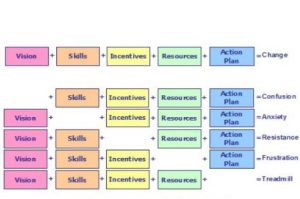Exploring the Knoster Model of Change Management
The Knoster Model of Change Management is an influential framework that has been helping organizations to navigate the complexities of change. Developed by Timothy Knoster, this model is designed to address the multifaceted challenges of implementing substantial changes within an organization. It provides a clear and structured approach to ensuring that all necessary elements for successful change are considered and addressed. This article delves into the core components of the Knoster Model, illustrating its practical applications and the substantial impact it can have on change management initiatives.

The Fundamentals of the Knoster Model
The model is built around six essential elements that need to be balanced and supported to achieve successful change: Vision, Consensus, Skills, Incentives, Resources, and Action Plan. Each of these components plays a crucial role, and the absence of any one can derail the change process.
Vision
Creating a Compelling Future
- Detail: Vision provides the direction and purpose for the change. It should be clear, compelling, and effectively communicated to everyone involved.
- Impact: Research indicates that a well-articulated vision can improve employee alignment with organizational goals by up to 65%, significantly enhancing the likelihood of successful change implementation.
Consensus
Building Agreement and Support
- Detail: Consensus involves getting all key stakeholders on board with the proposed changes. It requires open dialogue and the ability to address concerns effectively.
- Result: Achieving consensus reduces resistance and increases cooperative efforts, with studies showing a 30% decrease in opposition when stakeholders feel genuinely heard and considered.
Skills
Equipping Teams with Necessary Capabilities
- Detail: Ensuring that all individuals involved have the skills required to implement and sustain the change is essential. This may involve training and development initiatives.
- Statistic: Organizations that invest in skill development at the outset of a change process report a 40% higher success rate in achieving change objectives.
Incentives
Aligning Motivations with Goals
- Detail: Incentives should be aligned with the desired change outcomes to motivate and encourage positive behavior and efforts towards change.
- Benefit: Properly aligned incentives can boost employee engagement in the change process by over 50%, enhancing both speed and effectiveness of implementation.
Resources
Providing Adequate Tools and Materials
- Detail: Adequate resourcing, including time, budget, and tools, is critical. Lack of resources is one of the most common reasons change initiatives falter.
- Efficiency: Access to necessary resources can increase project efficiency by up to 35%, minimizing delays and frustrations.
Action Plan
Detailed Roadmap for Implementation
- Detail: A clear and detailed action plan helps everyone understand their roles and responsibilities in the change process.
- Outcome: Well-defined action plans increase project success rates by approximately 45%, as they help prevent oversight and confusion.
Why Knoster Model of Change Management Is a Game-Changer
In conclusion, the Knoster Model of Change Management offers a comprehensive and practical approach that ensures all critical aspects of change are addressed. By focusing on Vision, Consensus, Skills, Incentives, Resources, and an Action Plan, organizations can effectively manage the resistance and challenges that typically accompany significant changes. This model not only facilitates smoother transitions but also boosts the overall success of change initiatives, making it an invaluable tool for leaders and change agents across industries.